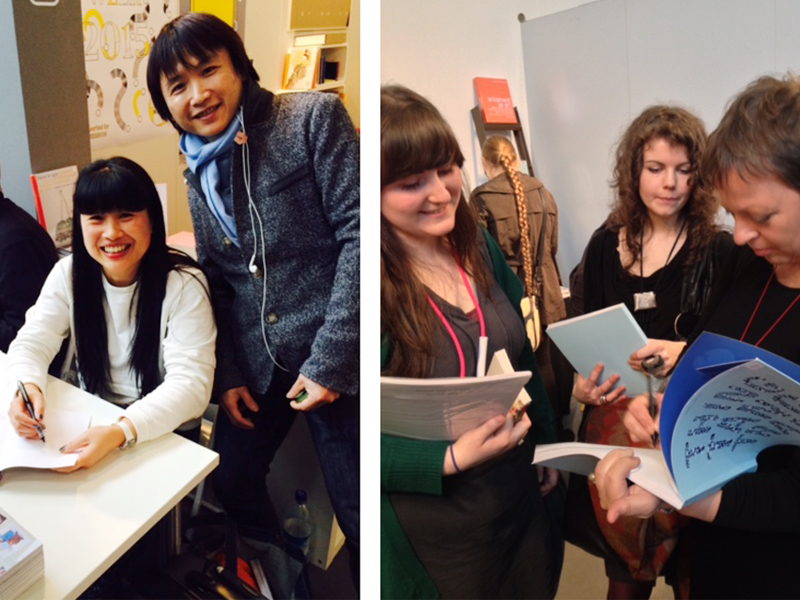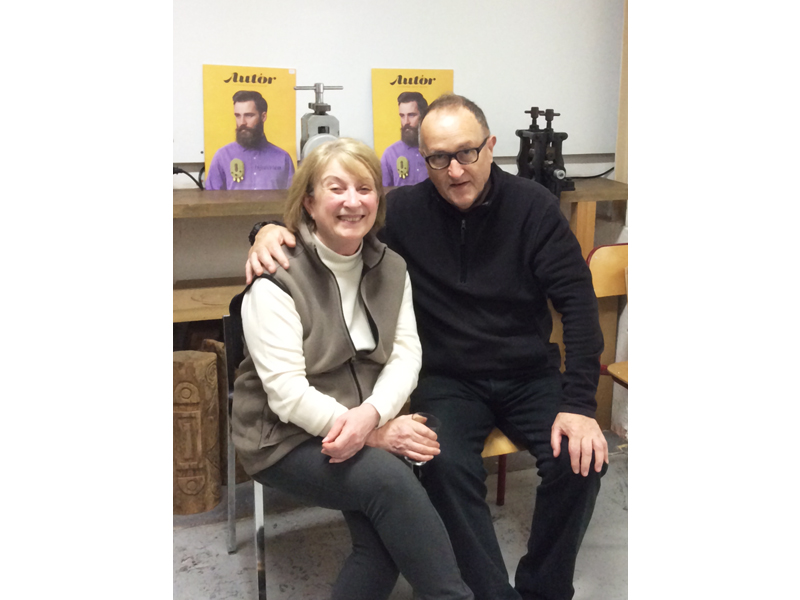
From its beginnings nearly 15 years ago at the Centre for Applied Arts library, Chrome Yellow Books has expanded into a household name in the world of art jewelry, touring Europe and appearing at events in Sweden, France, the UK, and of course at Schmuck in Munich, Germany. Today they are a conduit for new information about practicing jewelers and exhibitors, distributing exciting new publications and providing a platform for craft books beyond library stacks and gallery shops.
I joined Sonia and Michael Collins via Internet link from Suffolk, as they were preparing to take their books to the Royal College of Art in London for yet another show.
Sam O’Hana: What is Chrome Yellow Books all about? How did it come to be in its current format?
Sonia Collins: I worked for a London gallery called Contemporary Applied Arts for over 10 years and during the time I set up a library of books for sale. It became more and more popular: Tutors would bring their students in to buy and talk about books. I was then asked by the Association for Contemporary Jewellery to collate books for one of their conferences. This led me to sourcing books abroad on jewelry, from Gallery Ra and Gallery Marzee in Holland, for example.
Michael Collins: Gallery Marzee and Ra already had books on jewelry and we were familiar with them, but up to about 15 years ago some of the contemporary jewelers they exhibited were unknown outside of their gallery.
Sonia Collins: They were certainly new here, in England. I actually took it further after that and set up a showcase for European designers and I invited jewelers from different countries to show their work, which was very exciting but didn’t result in sales until about 12 years ago when Collect happened, the show put on by the UK Crafts Council.
Michael Collins: It brought in all those European galleries with artists that until recently had been unknown, but all of a sudden at the V&A and then Saatchi you could see their work.
Sonia Collins: Until then, no one really understood that contemporary jewelry was precious enough to collect, it had been mostly gold and silver, but seeing this work displayed in that manner, with the backing of the British Crafts Council, made its importance understood. From then on the books became much more collectible.
So the interest in art books rose alongside the emerging presence of art jewelry in the contemporary art world?
Sonia Collins: Yes, it spread through that. We’d already had quite a collection in the gallery and then when the gallery no longer wanted books because it needed the space, I decided to buy the stock of European art books they had.
Michael Collins: That’s when we started. I’d come from a different background with working in music and a bit of theater. It fitted well because we were going out and doing gigs all over—sometimes there’d be one man and his dog, another time there’d be 300 people. We were like an independent record shop, too, except it had these strange books in—not just jewelry but anything contemporary—textile, ceramic, and glass. All these fields we’ve built up now and sell.

You were touring the country selling jewelry books?
Michael Collins: Yes, mostly we’d find students or libraries and build their interest up like a fan base—it started with universities and we’d go to different countries—Germany where Otto Künzli was very generous with his help; France, where Ben Lignel supported us; and also Hans Stofer at the UK’s Royal College of Art. We had a few mentors like this—people who “got it” and thought we were a bit mad. I told Hans once, “I think it’s a bit mad really,” and he said, “I think you should get madder.” It’s a bit of an itinerant lifestyle, but we enjoy the people.
Sonia Collins: Somebody did once call us “gypsies with ideas,” like a traveling roadshow of ideas.
Michael Collins: Books—they’re like vinyl—they’re just more popular again, there are so many good new books and people still want them. Kindle came a bit late to the party—there are too many books still to be dealt with.
Sonia Collins: There are, but they’re not all good. Though when I do hear about a good book it’s often because we’ve got a good network of artists—they contact us if they’re going to be in a book or they know about one. I do think it’s important to promote artists—we don’t have to show their work, but we can show their books and catalogs. When an artist is published in an exhibition catalog, it’s hard to sell this book after the exhibition finishes. But when we take these catalogs to other galleries and universities to show to collectors and students, the artists feel really pleased they’ve got their work out there.

What is it about the world of contemporary European craft that a bookseller is needed?
Michael Collins: I think people, all the way from Otto Künzli to a very young artist, all understand the value of a book—to have your work released, rather like your first record, they all respond to that. We don’t have an agenda or any particular angle.
Sonia Collins: However, if it isn’t good it won’t sell. It needs to have good photography, but even that’s not enough now. It needs to have good critical writing. We found this over the years that to begin with people were only interested in coffee table books. But now it really has to have good critical writing.
Michael Collins: Yes, the format’s changed a lot—they’re often smaller. People want to get on planes with them and, like paperbacks, they want to read them rather than just look at them.
Sonia Collins: Images they can just see on the Internet. But if you’ve got a small pocket book and you’re interested in reading it, you’ve got the best of both worlds.
Other than this, what features do you look for in an outstanding craft publication? Is it something that you just know when you see it?
Michael Collins: With anything in sales, it’s always much better if it looks good. Without a good cover, people just gloss over it. Chrome Yellow Books has three main criteria: the right product to show to the right people at the right price. If you miss any one of those out, nothing happens. You can have a good book but it’s too expensive, or the wrong people come …
Sonia Collins: There has to be something about it that will make you want to open it.
Publishers like Taschen often produce very fine, highly finished books about art—what, by contrast, can small publishers offer to readers? Has anything come up through lesser-known names?
Michael Collins: Yes, but the aims have changed a bit now, people that travel a lot don’t want anything too big. At Munich, for example, people will say, “I like it but I can’t get it in my suitcase.” The format has downscaled a bit, bigger is not always better.
Sonia Collins: People are really interested in ideas—like books of interviews, or one from a conference. AJF is a prime example, whose publications reach everyone from students to tutors and artists. It’s a manual for these people, they get to see what’s currently going on and it’s not done in an overblown way—this is the right kind of format.
Students are also keen to buy books when they have dissertations to write, alongside their exhibitions.

Have there been any recent releases that surprised you as distributors? Something that you never thought you’d see in the market?
Michael Collins: We’ve been involved with a very interesting recycling project called JUNK: Rubbish to Gold. They will be exhibiting in Munich during the upcoming jewelry week.
There’s also new magazines, Current Obsession from the Netherlands, and out of Bucharest there’s Autor. They’re new and very trendy!
What’s your experience been of the digital-print divide in the world of art books?
Michael Collins: Each year in London there’s an event called New Designers where students show their work at a fair. The first week, where the students are fashion and craft designers, we sell a lot of books, but in the next week, with graphic and automotive design, students want to download the information, or take just one page away. These designers use screens a lot more in their daily life than others, but those working in craft prefer a more hands-on approach.
Sonia Collins: Now, after 10 years, people do rely on us because we look closely at the work before selling it. We have to keep ahead of demand and show our buyers new titles they will take an interest in.
You supply universities as well—do you feel optimistic about the level of interest taken by the students and staff who are part of jewelry courses?
Michael Collins: For buyers, we don’t focus just on craft anymore, these books could be just as appealing to those in architecture, for example. If Grayson Perry wins the Turner Prize then there’s a resurgence of interest in ceramics, and it’s no longer called craft—it’s “art.”
Sonia Collins: It’s like when you think about the late David Bowie, he’s done so much more than just produce music, and has affected so many different fields. It’s been really good also to meet the artist in the studio, buy their book, and then take this to students at universities to show them how it’s done.
Are there any particularly good titles that might have slipped under the radar that you want people to hear about?
Michael Collins: There’s a lot of interesting books that are coming out of Scandinavia at the moment involving, for example, writers like André Gali and Jorunn Veiteberg.
Sonia Collins: Many of the really new publications come out in autumn, and a lot of good ones in time for Munich, too. So really we’re just waiting for the year’s new publications to come out right now. Schmuck is where we meet the international galleries and artists. That’s a really important event for us, and because they know that we’re there and we’re the book shop at the event, they will bring their publications to us. We can then take these back to England and show them.





